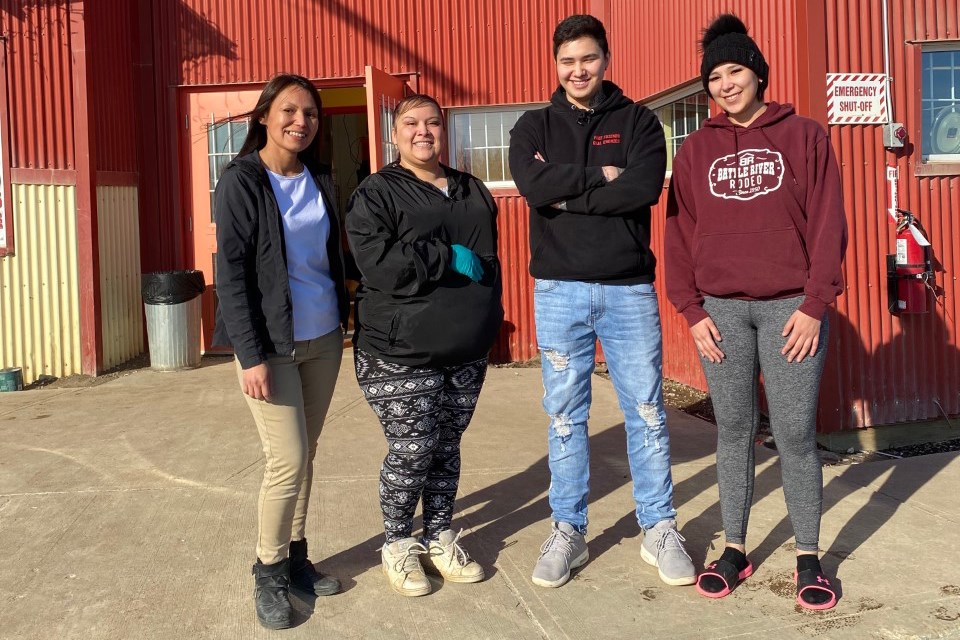Come fire, or now plague, the doors of The Bushe Store stay open.
“Everybody is trying to stick together,” said Myrna Chalifoux, manager of the gas station and store on the Bushe River First Nation near High Level, Alta.
In a time of what Alberta Premier Jason Kenney has called “profound adversity,” Chalifoux's warm laugh radiates calm through the phone.
Even as panicked shoppers clear store shelves amidst the threat of the COVID-19 pandemic, The Bushe Store remains open as a gathering place for surrounding Northern Alberta communities who come seeking a tank of gas and a sense of normalcy.
“We have a lot of people who stop in here to see what's going on, see how everybody is doing. We have our own little community at The Bushe,” Chalifoux said.
This isn't the first time The Bushe Store has served as a place of calm amidst a storm.
When the Chuckegg Creek wildfire raged toward High Level in May 2019 – burning more than 883,000 hectares, destroying 15 homes on the Paddle Prairie Métis Settlement and forcing some 5,000 Albertans to flee – it took down transmission lines, knocking out power just as evacuees prepared to drive hundreds of kilometres with their families to safety in Slave Lake.
The Bushe Store had its own generator, making it the only place evacuees could buy gas for miles.
Even as dark plumes of smoke hung overhead, staff, forgoing their own evacuation plans, worked together to keep the store open, providing gas and supplies first for evacuees, then for those working on the front lines of the wildfire.
“It's not as bad as the evacuation,” Chalifoux said of the current situation.
Even now, as they wait for the bare spots on their store shelves to be filled, her boss is trying to find supplies to make care packages for vulnerable people in their community who find themselves isolated by COVID-19, Chalifoux said.
Online and by word of mouth, they are offering to drop off supplies to those self-isolating.
Elders worried about coming inside can have their free coffee and popcorn brought to their car.
In an area where many people struggle with poverty and isolation at the best of times, Chalifoux said staff at The Bushe Store know how important it is for them to be there, ready to serve, in times of crisis.
Nearly one in three people in the Peace River area around The Bushe Store are First Nations or Métis.
One in 10 people live in poverty, a number that jumps to nearly one in five for children under the age of five.
Marc Miller, federal Minister of Indigenous Services, said the social determinants of health cannot be ignored in preparing Indigenous communities to face the Covid-19 pandemic.
“We can't shy away from the fact that Indigenous peoples in Canada are more vulnerable than non-Indigenous Canadians. We saw this during H1N1, we saw this during SARS,” said Miller, speaking to media on Thursday.
“We've learned from those events, but the reality remains that Indigenous people in Canada experience more overcrowding, a higher burden of chronic disease and some live in highly remote and isolated parts of this country,” Miller said. “It is exactly because of this heightened vulnerability that my department and this government is focused on the specific needs of Indigenous communities.”
During the H1N1 pandemic, according to the 2013 study Communicating Risk to Aboriginal Peoples: First Nations and Metis Responses to H1N1 Risk Messages, the so-called swine flu caused nearly 8,700 hospitalizations and 428 deaths Canada-wide.
Of those, 10 per cent were Indigenous, despite the fact they make up around four per cent of the total Canadian population.
During the first wave of the virus in 2009, people of Aboriginal descent made up nearly half of the hospitalizations and 18 per cent of the deaths caused by H1N1 in Canada.
Nearly one in four of those critically ill with H1N1 treated in hospital were Indigenous.
According to a report by the National Collaborating Centre for Aboriginal Health, health and human services in Indigenous communities quickly became overwhelmed during the 2009 H1N1 epidemic.
“Indigenous communities were three, four to five times more affected by H1N1 than non-Indigenous communities,” Miller said, adding the continued social disparity between Indigenous and non-Indigenous Canadians remains “unacceptable.”
Miller said investments in housing and water infrastructure in First Nations communities have “closed those socioeconomic gaps,” leaving them better prepared now in the face of COVID-19 – a coronavirus that has spread to more than 200,000 people across the globe claiming 16,500 lives – but there is more work to be done.
After first allocating $100 million in emergency funds to prepare Indigenous communities as the World Health Organization declared COVID-19 a global pandemic, the federal government announced an additional $305 million in funds on Wednesday to address the immediate needs of Indigenous communities as part of a $82-billion COVID-19 response package.
Tom Wong, Chief Medical Officer of Public Health for Indigenous Services Canada, said the ministry is helping bolster surge capacity in Indigenous communities and is working on developing and refining their emergency preparedness plans.
While experts cobble together data trying to chart a path through a COVID-19 pandemic set to peak in a month, Wong said they are including “culture as prevention, and culture as treatment and culture as resilience.”
Regulars at the Bushe Store understand the strength found in community during times of crisis, Chalifoux said, adding elders have brought together members of her community in prayer while they await the worst of whatever of the COVID-19 pandemic may bring.



